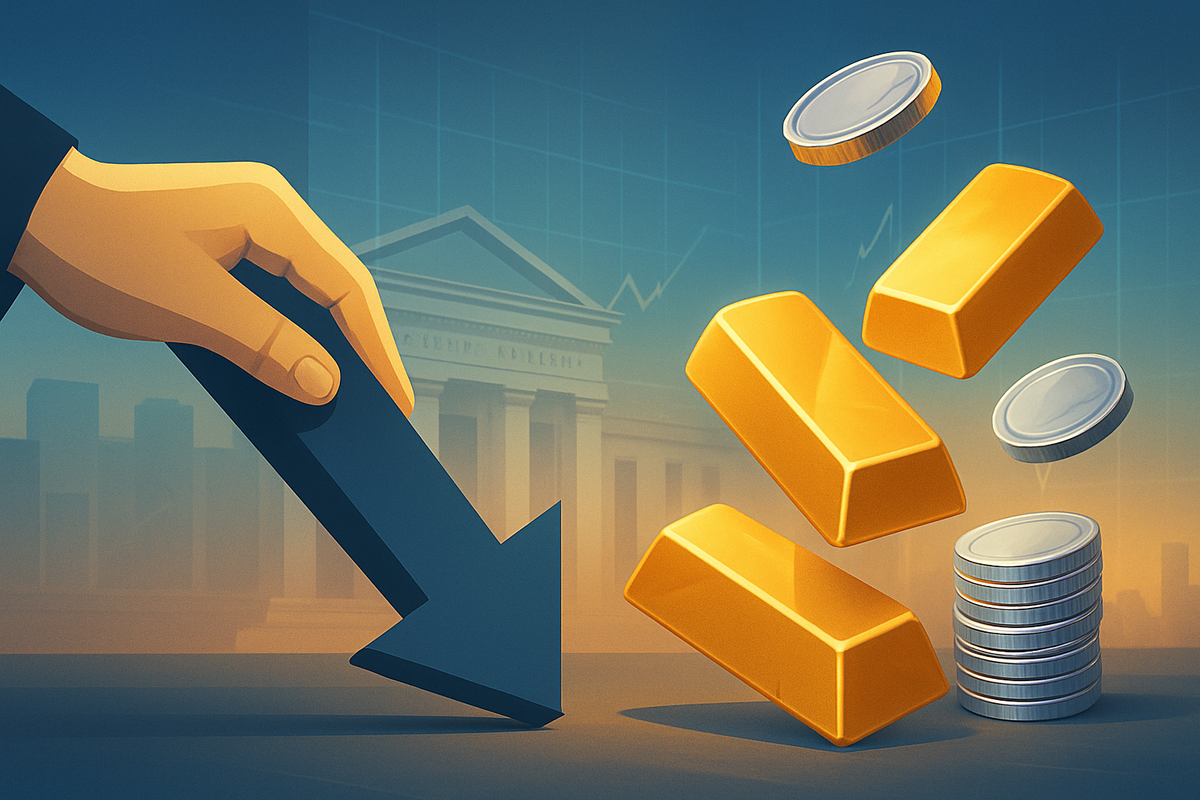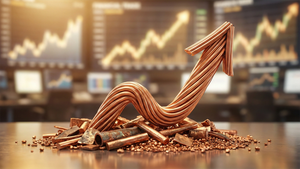
Washington D.C. – October 30, 2025 – The financial markets are abuzz as the Federal Reserve has firmly cemented its dovish pivot, a strategic shift from aggressive monetary tightening to an accommodative stance marked by a series of interest rate cuts. This policy reversal, which saw another anticipated 25-basis point reduction in the federal funds rate to a range of 3.75%-4.00% yesterday, October 29, 2025, has sent ripples across global asset classes, with particular excitement brewing in the precious metals sector. Investors are now recalibrating their portfolios, anticipating a sustained period of lower borrowing costs and a weaker U.S. dollar, factors historically bullish for gold and silver.
This significant policy adjustment comes as the Fed grapples with a softening labor market and moderating, though still somewhat elevated, inflation. The central bank's commitment to supporting economic activity has ignited fervent speculation about the trajectory of future interest rates, with market participants largely forecasting further easing. This environment is proving to be a potent catalyst for gold and silver, driving both commodities to multi-year highs despite a recent, albeit healthy, period of profit-taking.
The Fed's Calculated Retreat: A Timeline of Easing
The Federal Reserve's journey towards a dovish posture has been a gradual yet decisive one, unfolding over the past two years. The initial signals emerged in December 2023, when the Fed, while holding rates steady, revised down its 2024 interest rate projections, hinting at future cuts. The first tangible move came in September 2024 with a significant 50-basis point cut, breaking a four-year hiatus in rate reductions. This was followed by two more 25-basis point cuts in October and December 2024, bringing the federal funds rate to 4.25%-4.50% by year-end.
After a five-meeting pause in early 2025 to assess persistent inflation, rate cuts resumed in July 2025 with another 25-basis point reduction. A pivotal moment arrived in August 2025, when the Fed recalibrated its monetary policy framework, explicitly emphasizing maximum employment over strict inflation targeting, a clear signal of its accommodative leanings. September 2025 saw another "risk management cut," as described by Chair Jerome Powell, aimed at preempting a weakening labor market. Most recently, on October 14, 2025, Chair Powell publicly acknowledged the significant risk posed by a sharp slowdown in hiring, reinforcing the dovish outlook that culminated in the widely expected 25-basis point cut yesterday, October 29, 2025. This continuous easing has fundamentally reshaped market expectations, with bond futures traders now pricing in a near-certain 99% chance of another 25-bps cut in December 2025.
The immediate market reactions to this sustained dovish pivot have been largely positive, characterized by a "risk-on" sentiment. Equity markets, including the S&P 500 (INDEXSP: .INX), Nasdaq Composite (INDEXNASDAQ: .IXIC), and Dow Jones Industrial Average (INDEXDJX: .DJI), surged to new record highs following the 2024 rate cuts. U.S. Treasury yields have fallen, particularly for shorter-term maturities, and the U.S. dollar has generally weakened against other major currencies. However, there have been nuances; for instance, gold prices initially fell sharply after the September 2024 rate cut, an anomaly attributed to market interpretations of U.S. presidential election results at the time. Despite recent profit-taking, the overarching trend for precious metals remains bullish, driven by the reduced opportunity cost of holding non-yielding assets and increased safe-haven demand amidst global uncertainties.
Precious Metals Miners Poised for Gains, Broader Economy Benefits
The Federal Reserve's dovish pivot is creating a distinct landscape of winners and losers, with precious metals mining companies firmly positioned on the winning side. As the price of gold and silver continues to surge in response to lower interest rates and a weakening dollar, miners stand to see significant boosts to their revenues and profitability. Companies like Barrick Gold (NYSE: GOLD), Newmont (NYSE: NEM), Fresnillo (LSE: FRES), and Pan American Silver (NASDAQ: PAAS) are direct beneficiaries. Their cost structures, largely denominated in local currencies, remain relatively stable while the value of their primary products increases, widening their profit margins. This could lead to increased exploration budgets, expanded production, and enhanced shareholder returns through dividends or buybacks.
Beyond the direct impact on precious metals, the broader economy also stands to benefit from lower borrowing costs. Companies across various sectors, from technology to manufacturing, will find it cheaper to finance new projects, expand operations, and manage existing debt. This could stimulate investment, foster job creation, and potentially lead to a resurgence in corporate earnings. However, the exact impact will vary; companies with high debt loads or those heavily reliant on consumer spending may see more immediate benefits, while others might experience a lag. The financial sector, particularly banks, might face pressure on net interest margins due to lower rates, though increased lending activity could partially offset this.
Conversely, entities that thrive on higher interest rates, such as certain fixed-income investments or financial institutions heavily reliant on interest income, may experience headwinds. Savers relying on high-yield savings accounts might see their returns diminish. However, the overall sentiment is one of economic stimulation, with the Fed prioritizing growth and employment, which generally creates a more favorable operating environment for most public companies, albeit with varying degrees of direct benefit.
Broader Implications: A Shift in Global Financial Tides
The Federal Reserve's dovish pivot is more than just an adjustment to interest rates; it signifies a broader shift in global financial tides with profound implications. This move fits squarely into a trend of central banks worldwide increasingly prioritizing economic growth and employment stability over strict inflation targeting, especially in the face of slowing global economic momentum. The potential ripple effects are extensive, influencing international capital flows, currency valuations, and commodity markets beyond just gold and silver. A weaker U.S. dollar, a typical consequence of a dovish Fed, makes U.S. exports more competitive and can ease debt burdens for countries with dollar-denominated debt, potentially stimulating global trade.
Regulatory and policy implications are also at play. The Fed's recalibrated framework, emphasizing maximum employment, signals a more proactive approach to supporting the labor market, potentially influencing future government fiscal policies to align with monetary easing. However, the persistent inflationary pressures, partly fueled by new tariff policies, present a delicate balancing act for the central bank. Historically, periods of sustained monetary easing have often led to asset bubbles and, eventually, renewed inflationary pressures. Comparisons to past easing cycles, such as those following the 2008 financial crisis or the early 2000s, suggest that while economic recovery can be spurred, vigilance against overheating is crucial. The current environment, however, differs due to ongoing geopolitical uncertainties and supply chain complexities, adding layers of unpredictability.
This pivot also highlights the evolving role of central banks in managing complex economic landscapes, where traditional tools must adapt to new challenges. The "reluctant dove" argument, where some analysts suggest the Fed might be easing more cautiously than market expectations, underscores the ongoing debate within the FOMC. Nevertheless, changes in the composition of the Fed's Board of Governors are expected to solidify a stronger dovish bias, ensuring this policy direction continues to shape the market narrative for the foreseeable future.
What Comes Next: Navigating a Bullish but Volatile Path
Looking ahead, the Federal Reserve's dovish pivot sets the stage for a compelling, albeit potentially volatile, period for financial markets. In the short-term, market participants are widely anticipating further rate reductions. With a high probability of an additional 25-basis point cut in December 2025, and projections extending into 2026 and 2027 potentially bringing the federal funds rate down to around 3% by the end of 2026, the environment remains highly favorable for precious metals. The conclusion of the Fed's quantitative tightening program by December 2025 will further remove a headwind for liquidity, providing additional tailwinds for gold and silver.
For investors, significant market opportunities are emerging, particularly in gold and silver. Projections suggest gold could target $4,400-$4,500 per ounce by year-end 2025, with silver potentially eyeing $60-$75 per ounce, and even higher long-term potential. However, these opportunities come with challenges. The recent "significant downturn" and "nuanced correction" in October 2025, driven by profit-taking and clearer signals of easing U.S. inflation, serve as a reminder of the inherent volatility. Investors should be prepared for potential price swings, even within a broader bullish trend. Strategic pivots or adaptations may be required, focusing on risk management and diversification.
Potential scenarios include a continued, steady march lower in interest rates, bolstering risk assets and precious metals. Alternatively, unforeseen inflationary spikes or geopolitical events could force the Fed to pause or even reconsider its easing path, introducing uncertainty. Nevertheless, the current trajectory points towards a sustained period of accommodative monetary policy, creating a fertile ground for assets that benefit from lower real interest rates and a weaker dollar.
Wrap-Up: A New Era for Precious Metals and Economic Growth
The Federal Reserve's dovish pivot marks a significant turning point in monetary policy, transitioning from a period of aggressive tightening to one of deliberate easing. The key takeaway is a central bank increasingly focused on nurturing economic growth and employment, even if it means tolerating slightly higher inflation for a period. This shift has profound implications, most notably igniting a powerful rally in gold and silver, which have emerged as key beneficiaries of the new monetary landscape. While recent profit-taking introduced some volatility, analysts largely view this as a healthy correction within a robust long-term bullish trajectory for precious metals.
Moving forward, the market is poised for continued interest rate reductions, which will likely keep the U.S. dollar under pressure and further reduce the opportunity cost of holding non-yielding assets like gold and silver. This environment is generally supportive of risk assets and could stimulate broader economic activity by lowering borrowing costs for businesses and consumers. However, investors must remain vigilant. The interplay between inflation, labor market data, and geopolitical developments will continue to shape the Fed's decisions and, consequently, market sentiment.
In the coming months, investors should closely watch for further communications from the Federal Open Market Committee (FOMC), upcoming inflation reports (such as the Consumer Price Index, CPI), and key labor market indicators. These will provide crucial insights into the pace and extent of future rate cuts and the overall health of the economy. While the bullish case for gold and silver appears strong, a balanced approach, mindful of potential volatility and evolving economic conditions, will be paramount for navigating this new era of accommodative monetary policy.
This content is intended for informational purposes only and is not financial advice






